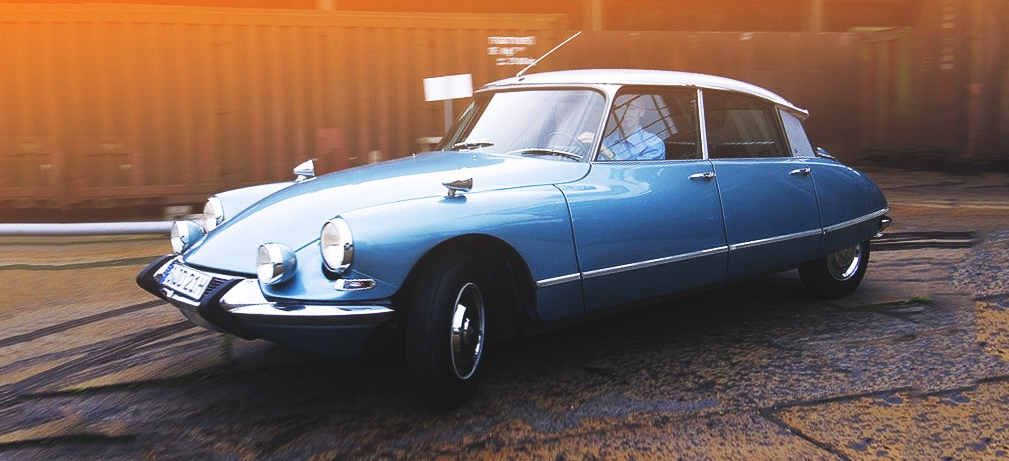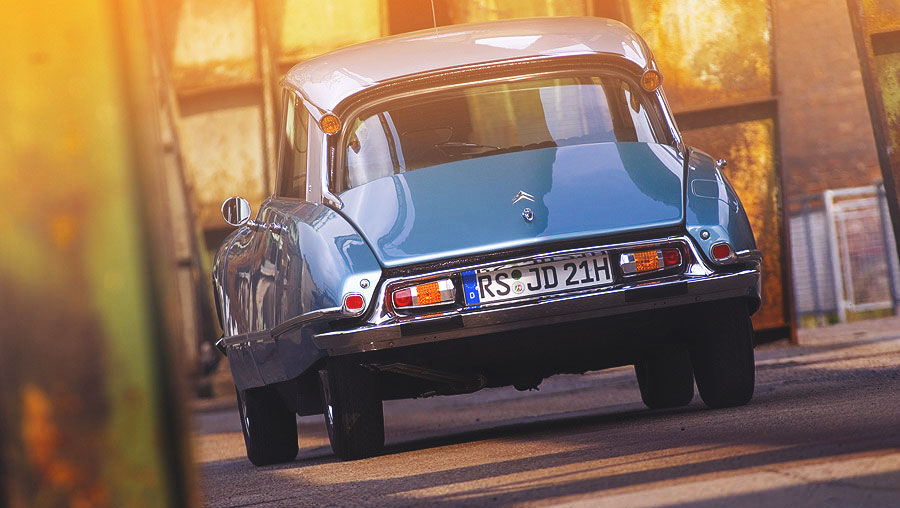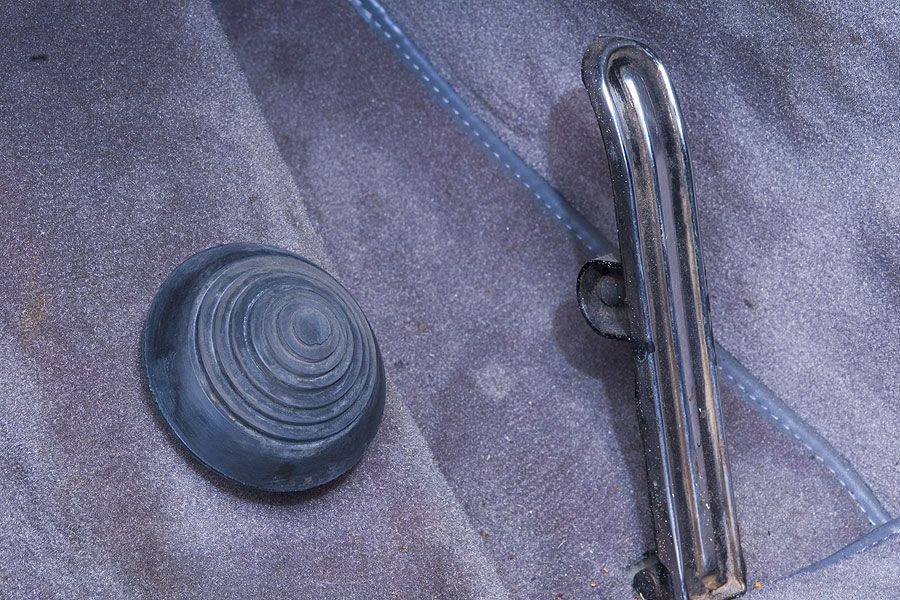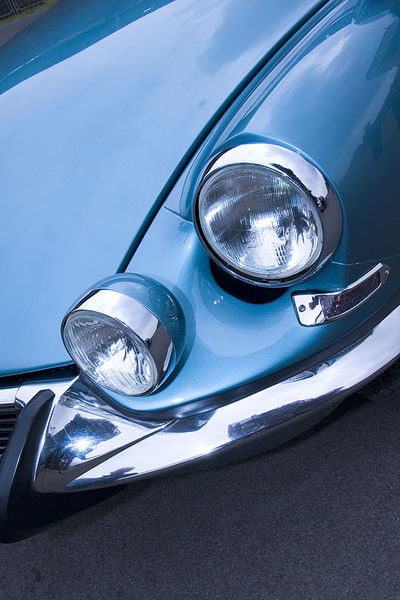
When the unique Citroen DS19 was first introduced at the Paris Salon in 1955 it was clear that here was a worthy successor, both in advanced design and model longevity, to the 20-year-old traction avant which it replaced. Because of its complex novelty, and the extensive use of power hydraulics for suspension, brakes and other services, it encountered initial sales resistance on both sides of the Channel. However, continuous development has established the car in the eyes of the public, while at the same time service facilities for its unconventional features have become more widely available.

Five years have passed since the model was last tested by The Autocar, and in that period there have been many detail changes. Recent comprehensive improvements in engine power, the hydraulic layout and seating have altered the characteristics of the car sufficiently to warrant a further test. The increase in power has been achieved by fitting a larger (24-32 DDC) double-choke Weber carburettor, and raising the compression ratio to 8.5 to 1 from 7.5 to 1 by means of domed-top pistons. These changes result in an output of 85bhp at 4,500rpm, compared with the former 75bhp; maximum speed has gone up from 87.1 to 91.5mph as a result, with an improvement in the acceleration figures. From standstill to 50 mph, for example now takes only 13 sec compared with 15.3, and to 70mph takes 25 sec compared with 31.4.

Modifications to the hydraulic circuit have simplified it, bringing it into line with the Safari estate car. These result in a more positive disengagement of the clutch when the car is standing in gear with the engine running. Finally, reclining front seats with adjustable rake to the back-rests are now standard equipment, instead of being listed as an extra. These modifications have not resulted in any increase in price, which still remains at £1,745 8s, inclusive of British purchase tax.
In performance, the car has lost none of its characteristic ability to cruise effortlessly all day long at relatively high speeds; on motorways it will maintain a “long-legged” 85mph without appearing in any way stressed. The high third gear can be regarded almost as a normal top on ordinary give-and-take roads, 91mph being attainable in this ratio.
The engine — four cylinders, 1,911 cc, with opposed valves operated by push-rods and rockers in an aluminium cylinder head — is in unit with the gearbox and front final drive. Some engine roughness is apparent, though it did not become obtrusive throughout the speed range. The ability of this unit to propel the large, 28 cwt family saloon at speeds in excess of 90mph is in itself creditable enough, but to do so at a fuel consumption of 29.2mpg over 1,953 miles of hard driving is astonishing. Although the higher compression ratio requires the use of premium-grade fuel, the improvement in consumption over the last recorded figure of 24.2mpg more than compensates for the increased petrol cost. The average owner no doubt would get a figure of 30mpg or more for long-distance out-of-town journeys.

Road noise is scarcely noticed, the floor being very well insulated. At speeds up to 80mph wind noise is low; but above this figure air depression pulls the frameless windows -way from their seals and a noisy whistle results. The engine started by moving the gear lever to the left of the neutral position, a feature which precludes any possibility of starting in gear. Initial use of the choke is required for cold starts, even in warm weather, but the engine fires immediately and runs evenly without hesitation.
Because of a slight delay between opening the throttle and the engagement of the automatic clutch, there is a tendency to overspeed the engine when manoeuvring in confined spaces; the result is that the clutch engages sharply, causing the car to leap forwards, whereupon the subsequent sharp braking causes an equally unseemly dive. The surest way to prevent this is to keep the left foot on the brake, and work the throttle against light braking.
Citroen, back in 1955, were the first company to produce a family saloon with disc brakes. Mounted on the inboard end of the front drive-shafts, they are applied by pressure drawn from the main hydraulic circuit — as are the conventional two-leading shoe drum brakes at the rear. Ever since the DS19 first appeared, a “button” brake pedal, situated on the floor (as opposed to the sloping toe board), has replaced the conventional brake pedal. Although its movement is confined to perhaps only a quarter-of-an-inch, delicate control is possible, the action being reasonably light.

The button is some distance from the accelerator pedal- some thought too far for comfort if the right foot is used for braking, and too far to the right for left-foot braking. Little fault, however, could be found with the brakes themselves; at no time, even over Alpine passes, was it possible to make them fade. Very heavy applications caused a degree of front wheel locking, but although the action was never completely smooth, there was never any uneven pulling.
Parking Brake Arrangement
Like the main brake pedal, the parking brake is also unusual in its layout. It consists of a pendant pedal, mounted in the position normally occupied by the clutch. Beneath the facia, above the pedal, is a two-position control knob; in one, the parking brake is locked on automatically, and it is released only by use of the knob. With the knob in the second (release) position, the parking brake can be used as a normal brake pedal. Being linked mechanically to the front disc brakes, however, without power assistance, it requires far greater pressure, though, with a pedal pressure of 150 lb, it will lock the front wheels.
The gear-change lever, mounted on the facia in front of the steering wheel, operates in an unusual gate. As mentioned previously, the engine is started by moving the lever to the extreme left of neutral. A forward movement engages first gear, with a straight pull back into second, and a curving movement to the right for third and top. Reverse lies to the right of the first gear position.

The new centrifugal cut-out ensures that the clutch is withdrawn at engine speeds below 1,200rpm; at higher engine speeds, movement of the gear lever into any position other than neutral withdraws the clutch automatically, selects the gear and takes up the drive. To move off from rest with first gear and increasing the engine speed. Thereafter, gear changing involves moving the lever into the required position, road speed. Full power changes are possible, but there is nothing to be gained from them.
Combined hydraulic actuation of the gear-change lever and the clutch involves a time lag which makes quick changes impossible. In normal circumstances this is no great inconvenience, but it can be tiresome CHI hills when changing up from first to second. There is very good synchromesh between the top three ratios, but changes into first are very nearly at rest. For low speed manoeuvring, incidentally, the engine speed is set to give a slow creep when first gear is engaged but to idle slower when the footbrake is on.
Perhaps the most unusual feature of this car is the ride, which is supremely comfortable. The fully independent, pneumatic suspension, with hydraulic damping and automatic levelling control, irons out most surface inequalities. The extremely wide track, which was also a feature of this car’s predecessor, the anti-roll torsion bars fore-and-aft and a very low centre of gravity virtually cut out roll on cornering, even when the car is driven very fast.
For long distance touring, therefore, in which the car is at its best, the degree of comfort and relaxation are excellent. However, it is possible sometimes to “catch out” the suspension and, for example, a certain type of bump which conventional suspension will take in its stride, can make the DS19s pneumatics react so violently that rear-seat passengers will hit their heads on the roof. Also, a dip in the road, if it is sudden enough, will cause the suspension to bottom on its stops with considerable violence.

At the other end of the scale, the effect of minor bumps such as potholes and cats’ eyes is somewhat noisier than with normal cars, but between these two extremes the car takes everything in its stride. The automatic levelling device, which allows air to pass into or out of the spring chambers, compensates for changes in passenger and luggage load, and keeps the car at a constant height above the road, without altering the spring rate; the ride is equally comfortable, therefore, with only the driver or a full load of passengers on board and the basic pitch of the headlamp beams remains constant.
On straight roads, with its power-assisted rack-and-pinion steering, the car has remarkable straight-line stability, though surprisingly the self-centring action is not over strong, particularly on large steering locks. The directional stability is unaffected by humps or camber changes, an inherent characteristic of front-drive cars, and no road shock is transmitted to the steering wheel.
As with most examples of front-wheel drive, the Citroen is an inherently understeering car, the degree of understeer appearing to be little affected by the amount of throttle used. A particularly good point is that there is no indication at the steering wheel of changes from drive to overrun. The cornering and road-holding are excellent, and even on rough roads the car feels entirely safe. On wet roads there is very little tendency for the tail to slide when the car is cornered fast.
The seating position is good, high enough without putting the driver’s eye level anywhere near the top of the screen, but more rearward adjustment for the front seats would be appreciated. All seats are trimmed in leather with rather firm upholstery, and they give little lateral support during fast cornering.
Door trim pads are also covered with leather, large padded armrests are fitted to the passengers’ doors and there is a folding centre armrest in the rear. The headlining and cant rail trim is carried out in cream, washable leathercloth, while good quality carpets with thick foam rubber underlays cover the floor front and rear.
Visibility from all seats would be hard to better. The screen pillars are commendably thin and the screen wide and deep, so the only real obstructions to an all-round view are the small rear quarter panels. For parking, the only location points visible from the driving seat are the sidelamp tell tales, which indicate width but not length. The driving mirror is mounted low and gives degrees of rearward vision cut-off varying with suspension movement.
Practical Instruments and Switches
In keeping with the rest of the car, the facia panel is different but practical. The sloping cubbybox lid occupies most of the passenger side, and the instruments are in a small inset panel in front of the driver. The single-spoke steering wheel, with cream plastic bound rim, permits an uninterrupted view of the three round dial instruments, a trip speedometer, fuel contents gauge and ammeter. Small warning lights give indication of headlamp main beam, oil pressure or charging failure and low hydraulic fluid level. Below the middle of the facia is a small switch panel and underneath this a console with an aperture for a radio. The main lighting switch is a typical French stalk pattern; turning the knob switches the lamps, pressing it blows the horns and pushing the whole stalk dips the headlamp beam. The whole of the facia is painted matt black.

The heating and ventilating system is very complete. Grilles at either end of the facia panel admit fresh air to the car and there are controls for both the direction and quantity of this supply. The heating system is separate; air engine bulkhead.
The single-speed electric windscreen wipers have large blades, sweeping a big area, but because of the size of the windscreen still leave an unwiped triangle in the middle of ‘the glass. In showers, after a dry spell, they quickly cleared the screen of traffic film. An electrically controlled screen- washer obtains its pressure from the spare wheel by way of a tube connection. The luggage space in the boot is deep and unencumbered, the spare wheel being stowed under the bonnet ahead of the radiator.
There are six greasing points on the car, four on the front unusual service attention is to keep check of the fluid level in the large reservoir required by the hydraulic system. This is facilitated by a sight glass on the side of the container.
Persistence on the part of the manufacturers has undoubtedly made a commercial and technical success of the DS. Through its unconventional design it offers many advantages without incurring too many liabilities in the way of special driving techniques or difficult service problems. Experience has proved that it is a long-lived car, and a buyer today can be sure that his purchase will not be outdated for years to come.
Few could complain at the space contained in this vast “maw”, which is square, unrestricted, and has no projections to damage suitcases.
Even after five years, the lines are strikingly refreshing and dean. Slim screen pillars and a large area of glass give an excellent all-round view from within.
The engine occupies a relatively small proportion of the considerable underbonnet space, and is shrouded to some extent by the complicated hydraulic system — but spare wheel, tools, screen-wash and hydraulic reservoirs, air-cleaner and battery are all extremely accessible.
Even the most stiff-limbed should have no difficulty in getting into the front or rear compartments. Large armrests are built into all four doors and the deeply upholstered seats are trimmed in leather.
Flashing indicators are at roof level. At both wing extremities are red reflectors, and at each side of the registration plate recess are built-in reversing, rear, and brake lights. The roof is a glass-fibre moulding.
A matt black finish is used, aircraft style, on all parts immediately below the screen, reducing reflections to a minimum. The pendant pedal on the left is a parking brake, and the small “button” is the brake pedal.
| MAXIMUM SPEEDS AT TEST | |||
| Gear | mph | kph | rpm |
| Top (mean) | 91.5 | 147 | 4500 |
| (best) | 95.1 | 152.9 | 4600 |
| 3rd | 91 | 146.5 | 5000 |
| 2nd | 60 | 96.6 | 5000 |
| 1st | 32 | 51.5 | 5000 |





